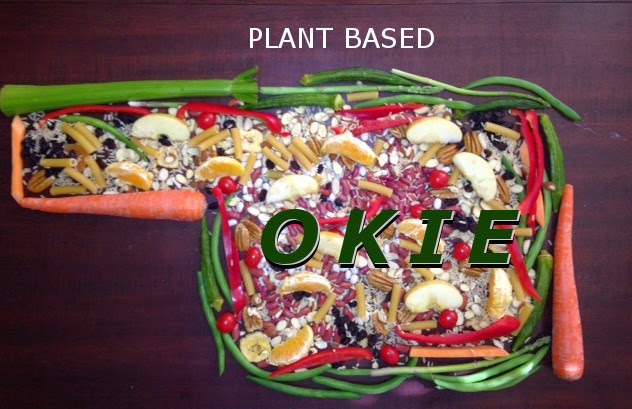Hello world. This is Plant Based Okie Jr. here writing a guest blog! Lets get right to it....
If you don't like tacos, then the terrorists have won.

Slight exaggerations notwithstanding, I love Mexican food. I'm a sucker for Tex Mex, straight up Mexican food with a coke cause the water isn't sanitary Mex, or even plant based clean-out-the-fridge Mexican food. Anyhow this is what the spread ended up looking like.Not pictured are some silly big taco shells that more so ended up being tostadas (flat toasted tortillas instead of a curved taco shell).
The "meat" is veggie burgers I pulled from the freezer, thawed out, and sauteed with a little bit of olive oil, also with some sauteed green bell peppers and onions. It worked really well.
Cooking 101, for sauteing you want to have your pan really hot before you drop in your ingredients. If it doesn't sizzle, then pull it out and wait till the pan is hotter
 Here's where I could improve. I wanted to toast some taco shells in the oven but had never done it before. I was tired of buying them from a plain corn tortilla shells from a box that have a markup that would make Hallmark cards execs jealous (ITS A CARD WITH 12 WORDS ON IT AND ITS 3 DOLLARS?! THAT'S A BUCK FOR EVERY 4 WORDS! THE HUMANITY!)
Here's where I could improve. I wanted to toast some taco shells in the oven but had never done it before. I was tired of buying them from a plain corn tortilla shells from a box that have a markup that would make Hallmark cards execs jealous (ITS A CARD WITH 12 WORDS ON IT AND ITS 3 DOLLARS?! THAT'S A BUCK FOR EVERY 4 WORDS! THE HUMANITY!)The problem was that middle crossbar on the oven racks got in the way for these 12 inch tortillas. When I tried 6 inch, they were too small, so I've still got some tinkering to do.
 Okay now toast yourself up some chips. I bought plain Jane 6 inch corn tortillas, cut them into quarters and toasted them right alongside my Godzilla sized taco shells. Unless you hate whomever is washing the dishes, grease the pan, and put a little oil of your choice on top of the tortillas as well.
Okay now toast yourself up some chips. I bought plain Jane 6 inch corn tortillas, cut them into quarters and toasted them right alongside my Godzilla sized taco shells. Unless you hate whomever is washing the dishes, grease the pan, and put a little oil of your choice on top of the tortillas as well.I baked them for two reasons. One is that we already had beans, guac, and veg burgers so it was already a fairly heavy meal. Two is that frying at home is a mess. It would be slightly tastier if fried, but waaay more fatty.
At the end of the day I ended up with something like this. It was somewhere between being a tostada/taco/nachos, but who cares what its called? It was tasty and dare I say healthy? Now go on young Padiwan, make yourself some tacos. Oh, and squeeze some lime on it.
(guac recipe is avos, onion, garlic, lime, lime zest, salt, jalapeno and cilantro)
(pico recipe is roma tomatoes, cherry tomatoes, lime, cilantro, jalapeno, salt, and a splash of apple cider vin)
google for 1000s of recipes, or just use a variation of what you had in the fridge. That's what I did. Taste, tinker, rinse, repeat.











































